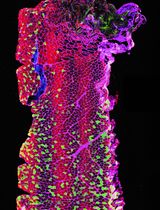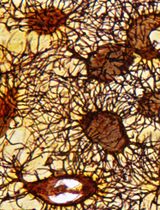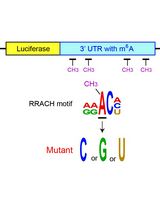- EN - English
- CN - 中文
E15.5 Mouse Embryo Micro-CT Using a Bruker Skyscan 1172 Micro-CT
使用Bruker Skyscan 1172显微CT对E15.5小鼠胚胎进行显微CT检查
发布: 2023年05月05日第13卷第9期 DOI: 10.21769/BioProtoc.4662 浏览次数: 1381
评审: Alberto RissoneEVANGELOS THEODOROUAbhilash Padavannil
Abstract
X-ray computed microtomography (µCT) is a powerful tool to reveal the 3D structure of tissues and organs. Compared with the traditional sectioning, staining, and microscopy image acquisition, it allows a better understanding of the morphology and a precise morphometric analysis. Here, we describe a method for 3D visualization and morphometric analysis by µCT scanning of the embryonic heart of iodine-stained E15.5 mouse embryos.
Keywords: Imaging (成像)Background
Transgenic mouse models have been extensively used to study the roles of specific genes in heart development. Historically, to analyze morphological defects on heart formation in gain-of-function and loss-of-function models, the formalin-fixed paraffin-embedded embryos were sectioned and analyzed section-by-section. X-ray computed microtomography (µCT) is a powerful tool for visualizing the 3D morphology of the heart and performing morphometric analysis. µCT uses X-rays to create cross-sections of a physical object that can be used to recreate 3D models, reaching very high resolution (<1 µm). Here, we describe a method to apply this technique to biological samples. Our purpose was to study the cardiovascular system in the developing mouse embryo. This method overcomes the limits of traditional histology, such as the difficulty to obtain comparable sections, especially when working with very small and complex samples.
For µCT analysis of embryos, it is mandatory to increase the contrast of tissues. To this end, different methods and contrast agents are described in the literature, with small differences in protocols. The main agents available to this purpose and tested by the authors are iodine solution or phosphotungstic acid (PTA) (Wong et al., 2012 and 2013; Hsu et al., 2016; Handschuh and Glösmann, 2022). Osmium tetroxide is also used as a contrast agent, but because of its high toxicity it has not been tested by the authors. Both approaches of staining were previously used to study cardiac defects (Degenhardt et al., 2010; Lesciotto et al., 2020; Jamet et al., 2022). In our experience, the use of 2%–5% PTA solution requires methanol (3%–10%) to properly penetrate tissues. The concentration of PTA and methanol can be adjusted depending on the size of sample; for example, for small mouse embryos (E12.5), 3% of methanol should be sufficient; for E15.5 embryos, 5% methanol; and for large mouse embryos (E18.5), 10% of methanol should be necessary. We successfully used this method for the staining of E13.5 mouse embryos (Petrillo et al., 2018). Although the PTA method offers excellent contrast, it may cause artifacts due to sample shrinkage in embryos older than E13.5. The maximum size of the object suitable for the µCT is 50 mm; however, increasing sample size will reduce the resolution.
On the contrary, iodine-based staining offers good balance in terms of sample preservation and soft tissue contrast, especially for larger samples. In our experiment, in E15.5 embryos we used a 20% Lugol’s solution and 0.5% Tween-20. To preserve mineral structures, pH can be adjusted to 7.3.
Materials and Reagents
Mouse mating and embryo dissection
Petri dishes (100 mm) (BD Biosciences, catalog number: 351029 or similar)
35 mm cell culture dishes (BD Biosciences, catalog number: 352096 or similar)
Sterile disposable tubes (50 mL) (BD Biosciences, catalog number: 352070 or similar)
15 mL tubes
Mice
Pure ethanol (Sigma, catalog number: 493546)
Phosphate-buffered saline (PBS), without Ca2+ and Mg2+ (Life Technologies, Gibco®, catalog number: 10010)
4% paraformaldehyde (PFA) (Santa Cruz Biotechnology, catalog number: sc-281692)
70% ethanol (see Recipes)
Micro-CT sample preparation
Lugol’s solution (Sigma, catalog number: 32922)
Tween-20 (Sigma, catalog number: P1379)
Staining solution with contrast agent (see Recipes)
Equipment
Blunt forceps (FST Standard Pattern forceps or similar)
Fine forceps (Dumont #5 or similar) and scissors (FST, catalog number: 14060-09 or similar)
X-Ray computed microtomography Skyscan 1172 (Bruker)
This instrument is a desktop µCT equipped with a fully distortion-corrected 11 MP X-ray camera (a 12-bit cooled CCD camera coupled to scintillator). The X-ray source is 20–100 kV, 10 W, with a <5 µm spot size. 0.8 µm is the highest resolution (only for small samples) and 25 µm is the lower resolution. The maximum object size is 50 mm. Skyscan 1172 is equipped with three filter positions (None, 0.5 mm Al, or Al+Cu).
Software
DataViewer 1.5.4.6 (Bruker)
NRecon 1.4.4 (Bruker)
CTVox 3.3.0 (Bruker)
Procedure
文章信息
版权信息
© 2023 The Author(s); This is an open access article under the CC BY-NC license (https://creativecommons.org/licenses/by-nc/4.0/).
如何引用
Astanina, E., Petrillo, S., Genova, T., Mussano, F. and Bussolino, F. (2023). E15.5 Mouse Embryo Micro-CT Using a Bruker Skyscan 1172 Micro-CT. Bio-protocol 13(9): e4662. DOI: 10.21769/BioProtoc.4662.
分类
发育生物学 > 形态建成 > 器官形成
细胞生物学 > 组织分析 > 组织成像
您对这篇实验方法有问题吗?
在此处发布您的问题,我们将邀请本文作者来回答。同时,我们会将您的问题发布到Bio-protocol Exchange,以便寻求社区成员的帮助。
Share
Bluesky
X
Copy link












